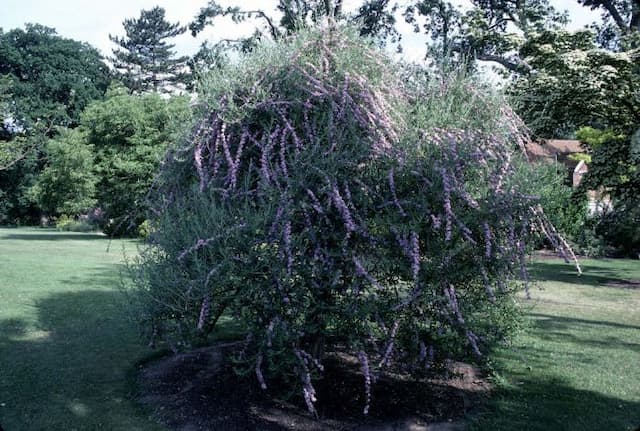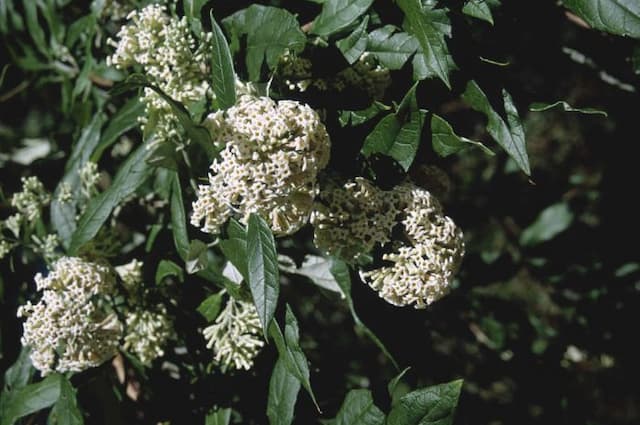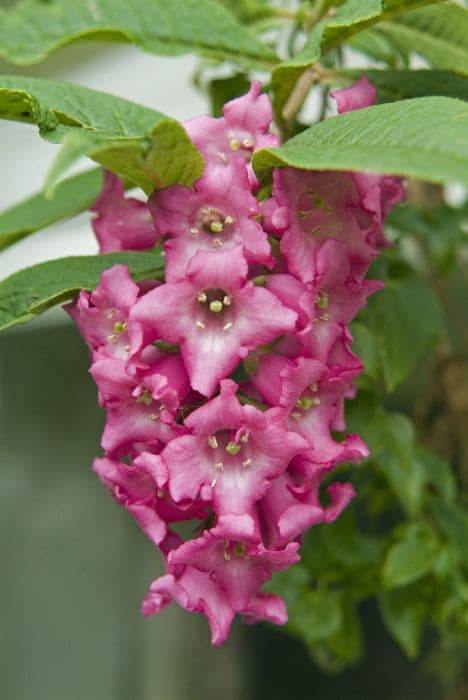Twinspur Diascia integerrima

ABOUT
Diascia integerrima, known as twinspur, is a flowering plant that is admired for its ornamental appeal. This plant typically bears a profusion of delicate blossoms that can vary in shade from soft pink to coral, and sometimes even a pale apricot color. Each flower is characterized by two prominent, spur-like extensions at the back, which is where the common name "twinspur" originates. The blooms are small and dainty, arranged in loose clusters atop thin, branching stems that create an airy display. The leaves of the twinspur are equally appealing. They are mostly lance-shaped or oblong, with smooth or slightly toothed edges, and appear in a rich green hue that contrasts beautifully with the colorful flowers. The foliage may grow densely, forming a lush and textured backdrop for the delicate blossoms. Twinspur's overall growth habit tends to be bushy and mounding, creating a soft, rounded shape that is well-suited to borders, rock gardens, and as a ground cover in suitable climates. The plant is also favored for its long blooming season, often providing color and interest throughout the warmer months.
About this plant
 Names
NamesFamily
Scrophulariaceae
Synonyms
Twinspur
Common names
Diascia barberae.
 Toxicity
ToxicityTo humans
Diascia integerrima, commonly known as Twinspur, does not have well-documented toxicity to humans. Most sources do not report it as a toxic plant. However, it is generally advisable not to ingest any plants or plant parts unless they are known to be safe and are prepared correctly. If a plant is not known to be edible, doing so could potentially result in gastrointestinal discomfort or more severe symptoms. Always consult a medical professional or a poison control center immediately if you suspect poisoning from any plant.
To pets
Diascia integerrima, or Twinspur, is not commonly listed as toxic to pets. However, as with humans, it is not considered an edible plant for pets either. Consuming non-edible plants might lead to mild gastrointestinal upset in pets, such as vomiting or diarrhea. If you suspect your pet has ingested any part of the Twinspur plant and is showing adverse symptoms, it is best to contact your veterinarian.
 Characteristics
CharacteristicsLife cycle
Perennials
Foliage type
Evergreen
Color of leaves
Green
Flower color
Pink
Height
1 feet 2 inches (35 cm)
Spread
1 feet 8 inches (50 cm)
Plant type
Herb
Hardiness zones
8
Native area
South Africa
Benefits
 General Benefits
General Benefits- Attracts Pollinators: Diascia integerrima is known for attracting bees and butterflies, which are crucial for pollination in the garden.
- Ornamental Value: It has a graceful habit and produces a profusion of attractive pink or coral flowers that add aesthetic appeal to garden beds or containers.
- Drought Tolerance: Once established, Diascia integerrima exhibits a degree of drought resistance, making it suitable for xeriscaping and low-water gardens.
- Easy to Grow: This plant is generally considered to be low maintenance, adapting to a variety of soil types and requiring minimal care.
- Long Blooming Season: It offers a long flowering period from spring to fall, providing extended color and interest in the landscape.
- Non-Invasive: Unlike some species that can become weedy, Diascia integerrima tends to stay contained within its planting area.
 Medical Properties
Medical PropertiesThis plant is not used for medical purposes.
 Air-purifying Qualities
Air-purifying QualitiesThis plant is not specifically known for air purifying qualities.
 Other Uses
Other Uses- Diascia integerrima, commonly known as twinspur, can be used as a natural dye, providing a variety of subtle colors when used in the textile industry.
- The plant's sprawling nature makes it a good choice for ground cover in gardens, helping to reduce weed growth and maintain soil moisture.
- Twinspur can serve as an important nectar source for beneficial insects, promoting biodiversity in a garden ecosystem.
- Due to its attractive blooms, Diascia integerrima can be utilized in floral arrangements and bouquets as a delicate filler.
- The plant's resilience to light frost makes it suitable for extending the flowering season in temperate gardens.
- Diascia integerrima can be used in educational settings to demonstrate plant propagation techniques, such as softwood cuttings.
- Its cascading growth habit makes it an excellent choice for adorning retaining walls or as spill-over plantings in raised beds.
- Twinspur can be planted to provide a contrasting texture alongside plants with large, bold foliage in mixed plantings.
- The flowers can also be pressed and used in craft projects, such as making bookmarks or decorating homemade cards.
- Photographers might utilize the vibrant colors of the plants as a natural backdrop for insect and small animal photography.
Interesting Facts
 Feng Shui
Feng ShuiThe Diascia is not used in Feng Shui practice.
 Zodiac Sign Compitability
Zodiac Sign CompitabilityThe Diascia is not used in astrology practice.
 Plant Symbolism
Plant Symbolism- Charm and Attractiveness: Diascia, often called Twinspur, has a delicate and charming aesthetic that symbolizes allure and the power to attract with its beauty.
- Persistence: Twinspur blooms prolifically and for a long duration, symbolizing persistence and the ability to thrive in various conditions.
- Companionability: Twinspur plants often grow well when paired with others, symbolizing the value of companionship and the importance of relationships in growth and survival.
 Water
WaterThe Twinspur, the common name for Diascia integerrima, prefers consistently moist soil, so you should water it when the top inch of soil feels dry to the touch. Depending on the climate and the environment, this could mean watering once every few days during active growth periods, typically in spring and summer. Aim to provide the plant with approximately one gallon of water per week, adjusting as necessary for rainfall and temperature conditions. Avoid overhead watering to prevent disease, and instead water at the base of the plant to keep the foliage dry.
 Light
LightTwinspur thrives in full sun to partial shade. It performs best when it receives at least 6 hours of sunlight a day, so positioning it in a spot that gets plenty of morning sunlight and some afternoon shade is ideal. Avoid deep shade as this can hinder flower production and lead to leggy growth.
 Temperature
TemperatureTwinspur, when grown outdoors, prefers temperatures ranging between 40°F and 85°F. It can tolerate lows down to about 30°F but should be protected from frost, as it is not frost-hardy. The ideal temperature range for promoting vigorous growth and abundant flowering is between 60°F and 75°F.
 Pruning
PruningPruning Twinspur is important for encouraging bushier growth and more abundant blooms. Pinch back the tips of the plant in the spring to promote branching. Deadhead spent flowers regularly to prolong blooming. Cut back the plant by about half at the end of the blooming season to keep it tidy and prepare it for the next growing season.
 Cleaning
CleaningAs needed
 Soil
SoilThe best soil mix for Twinspur, also known as Diascia integerrima, should be well-draining with a slight tendency towards acidity, ideally with a pH ranging from 6.0 to 7.0. A mixture consisting of potting soil, peat moss, and perlite in equal parts creates an optimal environment for root growth and health. Regularly check soil moisture as these plants prefer consistently moist but not waterlogged conditions.
 Repotting
RepottingTwinspur, commonly called Diascia integerrima, should generally be repotted every 1-2 years to prevent root crowding and replenish nutrients. Choose a pot only slightly larger than the current one to ensure healthy growth and avoid overpotting, which can lead to water retention issues.
 Humidity & Misting
Humidity & MistingTwinspur (Diascia integerrima) thrives in moderate humidity levels. Aim to maintain humidity around 40-50% for optimal growth. Avoid excessively dry air, which can stress the plant, and provide regular misting if indoor air is particularly dry.
 Suitable locations
Suitable locationsIndoor
Place Twinspur in bright, indirect light indoors; keep soil moist.
Outdoor
Plant Twinspur in sun to part shade; ensure well-draining soil.
Hardiness zone
9-11 USDA
 Life cycle
Life cycleDiascia integerrima, commonly known as the "spurflower," begins its life as a seed, which, when sown and exposed to the proper conditions of light, temperature, and moisture, will germinate. The seedling emerges, developing roots and a set of initial leaves, and as it matures, true leaves that are characteristic of the spurflower's foliage appear. As a juvenile, the plant continues to grow foliage and strengthen its stems, leading up to the flowering stage, wherein it produces distinctive pink or coral flowers that have a unique spurred shape. After pollination, often aided by bees that are attracted to the flower's shape and nectar, the plant sets fruits that develop seeds. Once mature, these seeds are dispersed by various means, such as wind or animal movement, to begin a new cycle. The spurflower is a perennial plant, which means it has a multi-year lifespan, going through repeated cycles of growth, flowering, and dormancy, depending on the climate and season.
 Propogation
PropogationPropogation time
Spring-Early Summer
The most popular method of propagation for the Diascia integerrima, commonly known as the Twinspur, is through sowing seeds. This is usually done in the spring after the last frost when the soil has warmed up to at least 70°F (21°C). Seeds should be lightly scattered over the surface of a well-draining soil mix in a seed tray or directly into the garden. They need light to germinate, so they should not be covered with soil but gently pressed into the surface. Watering should be done with care to maintain moisture without causing the seeds to rot. Germination typically occurs within 2 to 3 weeks, and once the seedlings are large enough to handle, they can be transplanted into individual pots or to their final positions in the garden.


![Butterfly bush [Berries and Cream]](/_next/image?url=https%3A%2F%2Fplants-admin.emdemapps.com%2Fimages%2Fplants%2F%2Fimages%2F604b650f667be.png&w=640&q=75)





